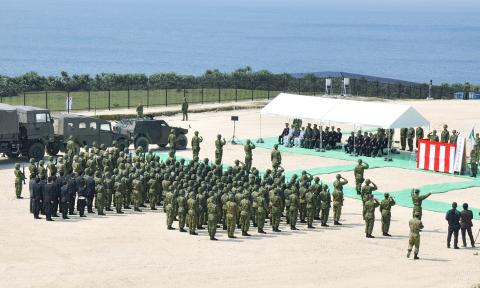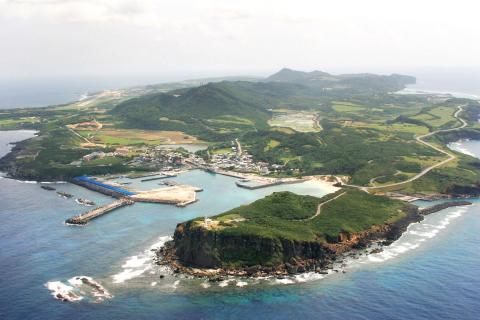Japan yesterday switched on a radar station in the East China Sea, giving it a permanent intelligence-gathering post close to Taiwan and a group of islands disputed by Japan and China, drawing an angry response from Beijing.
The new Japan Self-Defense Forces base on Yonaguni Island is at the western extreme of a string of Japanese islands in the East China Sea, 150km south of the Diaoyutai Islands (釣魚台) — known as the Senkakus in Japan. The Diaoyutais are claimed by Taiwan, China and Japan.
China has raised concerns with its neighbors and in the West with its assertive claim to most of the South China Sea where Taiwan, Philippines, Vietnam, Malaysia and Brunei have overlapping claims. Japan has long been mired in a territorial dispute with China over the East China Sea islands.

Photo: Reuters / Kyodo / Files
“Until yesterday, there was no coastal observation unit west of the main Okinawa island. It was a vacuum we needed to fill,” said Daigo Shiomitsu, a Ground Self-Defense Forces lieutenant colonel who commands the new base on Yonaguni. “It means we can keep watch on territory surrounding Japan and respond to all situations.”
Shiomitsu yesterday attended a ceremony at the base with 160 military personnel and about 50 dignitaries. Construction of some buildings, which feature white walls and traditional Okinawan red-tiled roofs, is still unfinished.
The 30km2 island is home to about 1,500 people, who mostly raise cattle and grow sugar cane. The Self-Defense Forces contingent and family members are to increase the population by 20 percent.

Photo: Reuters / Kyodo / Files
“This radar station is going to irritate China,” Nihon University professor and retired major general Nozomu Yoshitomi said.
In addition to being a listening post, the facility could be used as a base for military operations in the region, he added.
In a statement, the Chinese Ministry of National Defense said the international community needed to be on high alert to Japan’s military expansion.
“The Diaoyu Islands are China’s inherent territory. We are resolutely opposed to any provocative behavior by Japan aimed at Chinese territory,” it said. “The activities of Chinese ships and aircraft in the relevant waters and airspace are completely appropriate and legal.”
The listening post fits into a wider military buildup along the island chain, which stretches 1,400km from the Japanese home islands.
Policymakers last year told reporters it was part of a strategy to keep China at bay in the Western Pacific as Beijing gains control of the South China Sea.
Yonaguni is only about 100km east of Taiwan, near the edge of a controversial air defense identification zone established by China in 2013.
Over the next five years, Japan is to increase its Self-Defense Forces in the East China Sea by about 20 percent to almost 10,000 personnel, including missile batteries that would help Japan draw a defensive curtain along the island chain.
Chinese ships sailing from their eastern seaboard must pass through this barrier to reach the Western Pacific, access to which Beijing needs both as a supply line to the rest of the world’s oceans and for naval power projection.

LONG FLIGHT: The jets would be flown by US pilots, with Taiwanese copilots in the two-seat F-16D variant to help familiarize them with the aircraft, the source said The US is expected to fly 10 Lockheed Martin F-16C/D Block 70/72 jets to Taiwan over the coming months to fulfill a long-awaited order of 66 aircraft, a defense official said yesterday. Word that the first batch of the jets would be delivered soon was welcome news to Taiwan, which has become concerned about delays in the delivery of US arms amid rising military tensions with China. Speaking on condition of anonymity, the official said the initial tranche of the nation’s F-16s are rolling off assembly lines in the US and would be flown under their own power to Taiwan by way

OBJECTS AT SEA: Satellites with synthetic-aperture radar could aid in the detection of small Chinese boats attempting to illegally enter Taiwan, the space agency head said Taiwan aims to send the nation’s first low Earth orbit (LEO) satellite into space in 2027, while the first Formosat-8 and Formosat-9 spacecraft are to be launched in October and 2028 respectively, the National Science and Technology Council said yesterday. The council laid out its space development plan in a report reviewed by members of the legislature’s Education and Culture Committee. Six LEO satellites would be produced in the initial phase, with the first one, the B5G-1A, scheduled to be launched in 2027, the council said in the report. Regarding the second satellite, the B5G-1B, the government plans to work with private contractors

MISSION: The Indo-Pacific region is ‘the priority theater,’ where the task of deterrence extends across the entire region, including Taiwan, the US Pacific Fleet commander said The US Navy’s “mission of deterrence” in the Indo-Pacific theater applies to Taiwan, Pacific Fleet Commander Admiral Stephen Koehler told the South China Sea Conference on Tuesday. The conference, organized by the Center for Strategic and International Studies (CSIS), is an international platform for senior officials and experts from countries with security interests in the region. “The Pacific Fleet’s mission is to deter aggression across the Western Pacific, together with our allies and partners, and to prevail in combat if necessary, Koehler said in the event’s keynote speech. “That mission of deterrence applies regionwide — including the South China Sea and Taiwan,” he

‘NARWHAL’: The indigenous submarine completed its harbor acceptance test recently and is now under heavy guard as it undergoes tests in open waters, a source said The Hai Kun (海鯤), the nation’s first indigenous defense submarine, yesterday began sea trials, sailing out of the Port of Kaohsiung, a military source said. Also known as the “Narwhal,” the vessel departed from CSBC Corp, Taiwan’s (台灣國際造船) shipyard at about 8am, where it had been docked. More than 10 technicians and military personnel were on deck, with several others standing atop the sail. After recently completing its harbor acceptance test, the vessel has started a series of sea-based trials, including tests of its propulsion and navigational systems, while partially surfaced, the source said. The Hai Kun underwent tests in the port from